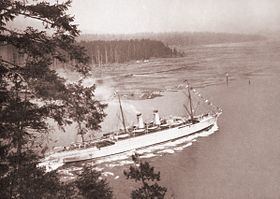Laid down 1890 Length 139 m Tonnage 5.357 million kg | Maiden voyage 8 February 1891 Construction started 1890 Beam 16 m | |
 | ||
Name 1891-1914 RMS Empress of India1915-1923 SS Loyalty Owner 1891-1914 Canadian Pacific Railway1914-1919 Maharaja of Gwalior1919-1923 Scindia Steam Navigation Port of registry 1891-1914 Canada1914-1923 British Raj Launched 30 August 1890 by Lady Louise Edgerton Builders Vickers-Armstrongs, Vickers Shipbuilding and Engineering | ||
RMS Empress of India was an ocean liner built in 1890-1891 by Naval Construction & Armaments Co, Barrow-in-Furness, England for Canadian Pacific Steamships. This ship would be the first of two CP vessels to be named Empress of India, and on 28 April 1891, she was the very first of many ships named Empress arriving at Vancouver harbor.
The Empress of India regularly traversed the trans-Pacific route between the west coast of Canada and the Far East until she was sold to the Maharajah of Gwalior in 1914 and renamed in 1915.
In 1891, Canadian Pacific Railway (CPR) and the British government reached agreement on a contract for subsidized mail service between Britain and Hong Kong via Canada; and the route began to be serviced by three specially designed ocean liners. Each of these three vessels was given an Imperial name.
The RMS Empress of India and her two running mates - the RMS Empress of China and the RMS Empress of Japan - created a flexible foundation for the CPR trans-Pacific fleet which would ply this route for the next half century.
History
The Empress of India was built by Naval Construction & Armaments Co. (now absorbed into Vickers Armstrongs) at Barrow, England. The keel was laid in 1890. She was launched on 30 August 1890 by Lady Louise Egerton, sister of Lord Harrington. The 5,905-ton vessel had a length of 455.6 feet, and her beam was 51.2 feet. The graceful white-painted, clipper-bowed ship had two buff-colored funnels with a band of black paint at the top, three lightweight schooner-type masts, and an average speed of 16-knots. This Empress and her running mate Empresses were the first vessels in the Pacific to have twin propellers with reciprocating engines. The ship was designed to provide accommodation for 770 passengers (120 first class, 50 second class and 600 steerage).
The SS Empress of India left Liverpool on 8 February 1891 on her maiden voyage via Suez to Hong Kong and Vancouver. Thereafter, she regularly sailed back and forth along the Hong Kong - Shanghai - Nagasaki - Kobe - Yokohama - Vancouver route. In the early days of wireless telegraphy, the call sign established for the "Empress of India was "MPI."
Much of what would have been construed as ordinary, even unremarkable during this period was an inextricable part of the ship's history. In the conventional course of trans-Pacific traffic, the ship was sometimes held in quarantine, as when it was discovered that a passenger from Hong Kong to Kobe showed signs of smallpox, and the vessel was held in Yokohama port until the incubation period for the disease had passed. The cargo holds of the Empress would have been routinely examined in the normal course of harbor-master's business in Hong Kong, Yokohama or Vancouver.
On 17 August 1903, the Empress of India collided with and sank the Chinese cruiser Huang Tai.
The vessel was reported sold on 19 December 1914, to the Geakwar of Baroda (also known as the Maharajah of Gwalior). The former Empress was re-fitted as a hospital ship for Indian troops. On 19 January 1915, the ship was renamed Loyalty. In March 1919, she was sold to The Scindia Steam Navigation Company Ltd. Company in Bombay (now Mumbai). In February 1923, the ship was sold for scrapping at Bombay.
CP Empresses of India
In 1921, Canadian Pacific added two German-built vessels to the Empress fleet; and initially, both were confusingly renamed Empress of China. Within months, one of these ships will be renamed the SS Empress of India and the other will be renamed the SS Empress of Australia. A quick explanation will help distinguish these quite different ships which each sailed with the same name.
This vessel from Barrow is the first of two CP ships named Empress of India.
